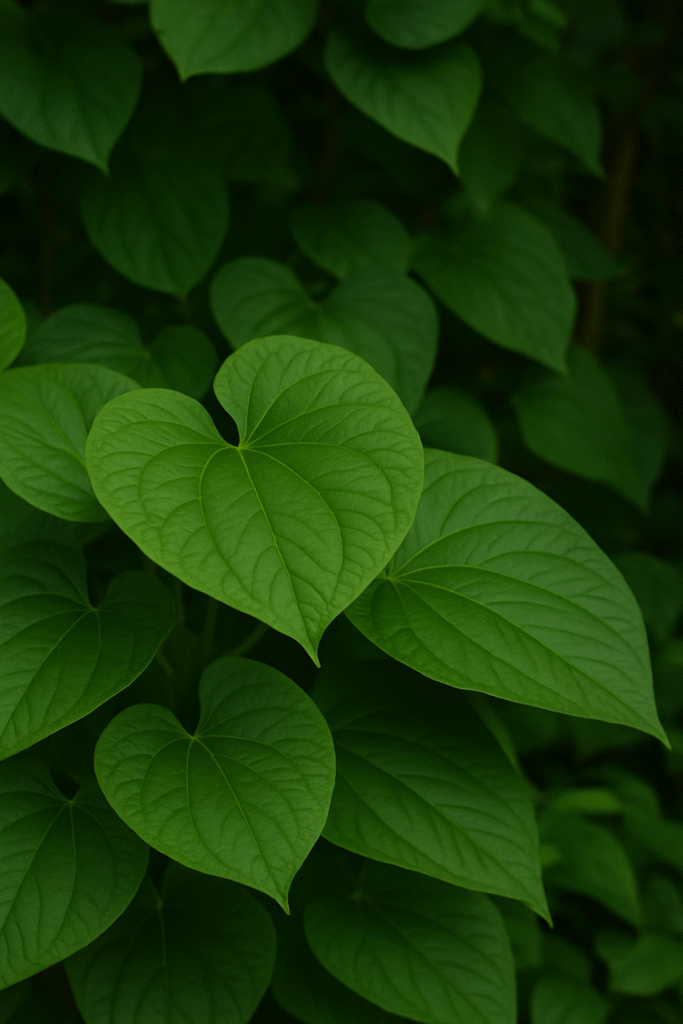Pariparoba, scientifically known as Piper umbellatum, is a native Brazilian plant from the Piperaceae family. It grows abundantly in the Atlantic Forest and other tropical regions of South America. Known for its broad leaves and therapeutic properties, Pariparoba is used both for medicinal purposes and as an ornamental plant in medicinal gardens. Its name comes from indigenous origins, and in different parts of Brazil, it’s also referred to as caapeba, field jaborandi, or wild balm.
This shrub can reach up to 1.5 meters tall and is easily recognized by its large, heart-shaped leaves with prominent veins. The leaves are the most utilized part of the plant, especially in teas, tinctures, or extracts. In spring and summer, it produces small white spike-shaped flowers.
Traditional Uses and Medicinal Properties
Pariparoba has a strong presence in traditional Brazilian medicine. Its leaves contain anti-inflammatory, analgesic, diuretic, digestive, and liver-protective properties. The tea is commonly used as a natural blood purifier, helping to eliminate toxins from the body.
Scientific research has identified phenolic compounds, flavonoids, and lignans in Pariparoba—these are responsible for its antioxidant and liver-protective effects. As such, the plant is being studied for potential use in the treatment of liver diseases, digestive disorders, fluid retention, and even muscular or joint pain.
Another traditional use is related to treating cold and flu symptoms. Pariparoba tea may help relieve cough, reduce respiratory inflammation, and act as a mild expectorant. The leaves are also used externally to help heal wounds and treat skin irritations through compresses or poultices.
Growing Pariparoba at Home
Pariparoba is a hardy plant that is easy to grow, making it a great choice for home gardens or herbal medicine plots. It thrives in warm, humid climates and prefers shaded or partially sunny locations.
The ideal soil should be fertile, rich in organic matter, and well-drained. Regular watering is essential, especially during dry seasons, to keep the plant healthy and ensure good leaf production.
For best growth, plant seedlings about 50 cm apart to avoid nutrient competition. Leaf harvesting can be done as needed, preferably choosing mature leaves. If not used immediately, they should be dried in the shade and stored in a dry, ventilated space.
Cautions and Safety
Although Pariparoba is a natural remedy, it should be used with caution. Like all medicinal plants, prolonged or high-dose use may cause side effects. People with severe liver conditions, pregnant women, and nursing mothers should consult a healthcare professional before consuming it.
Despite being generally safe when consumed in moderate doses, more clinical studies are needed to determine its long-term effects and recommended dosages. Responsible and moderate use is always the safest approach.
Cultural Significance and Sustainability
Pariparoba holds cultural importance beyond its medicinal value. Its use is rooted in the knowledge of Indigenous peoples and local communities across Brazil. Preserving this knowledge means respecting both biodiversity and the wisdom of traditional medicine.
Cultivating Pariparoba at home contributes to environmental conservation and reduces pressure on wild populations. Promoting the sustainable use of native medicinal plants is a way to connect wellness, cultural heritage, and ecology.
Water your medicinal plants with care!
Discover this Indoor Plant Watering Can, perfect for nurturing your Pariparoba and other home plants. It features a long spout for precise watering, a sleek green design, and a 1.8L (½ gallon) capacity—ideal for indoor and outdoor gardening.
Suggested product:
Indoor plant watering can, small watering cans for houseplants and garden flowers, long spout bucket for outdoor plant watering – 1.8L / ½ gallon (green)


